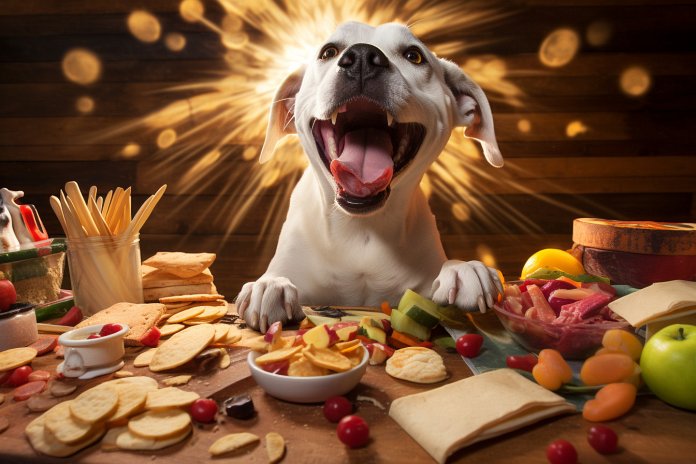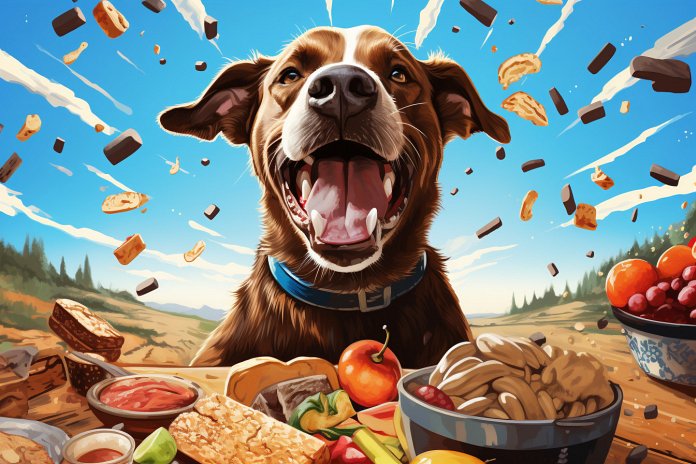
Fats are important for your dog’s diet, but too much can lead to weight gain and pancreatitis, while too little can cause constipation and dry skin. Fats not only provide essential nutrients, but they also make food taste good and smell appealing to dogs. As a responsible owner, be mindful of the fat content in your dog’s food and avoid giving them fatty treats meant for humans.
Signs Your Dog Likes Fatty Food:
By paying attention to your dog’s body language and behavior, you can identify their preference for fatty food. Sniffing, dropped ears, nose licking, and hanging tongue are all signs that your dog is attracted to the scent of fats. Some dogs may display begging behavior, while others may nudge or bark for food. If your dog enjoys the taste of fatty food, they will quickly finish their meal.
Body Language:
When your dog is a fan of fatty food, they may exhibit certain behaviors like sniffing, dropped ears, nose licking, and hanging tongue. Additionally, they may gaze at the food without breaking eye contact, display polite behavior in hopes of being rewarded, nudge you for food, beg for it, and gobble it up quickly.
History of Dogs Liking Fatty Food:
Both humans and dogs have a natural preference for fats. Dogs have fewer taste receptors compared to humans, but they share similar taste sensations for sweet, sour, salty, and bitter. While humans have a gene that makes some individuals more sensitive to fats, dogs also have the ability to taste fats, albeit to a lesser extent. Dogs are more influenced by the smell of fat than the taste.
The Science of Fatty Food for Dogs:
A healthy dog requires a balanced diet that includes 10-15% fat. Extra treats and table scraps should not be relied upon as fat sources. Feeding your dog bad fats and not providing enough exercise can lead to obesity and other health issues. Fats provide more energy than protein or carbohydrates, and they are essential for the normal development and function of the body. They also aid in reducing inflammation and facilitating vitamin absorption. Be mindful of the expiration date of your dog food to avoid feeding them rancid fats.
Training Your Dog to Eat the Right Foods:
Dogs can learn to eat the right foods with consistency and a positive approach from their owners. Establish a clear schedule for mealtime and remove the food after 20-30 minutes, regardless of whether the dog finished it. Avoid giving treats or snacks between meals to reinforce the mealtime schedule. If you need to change your dog’s food, do so gradually to avoid digestive issues. Watch for any negative reactions to new foods and use treats as rewards during training sessions.
Conclusion:
Understanding your dog’s preference for fatty food can help you provide a balanced diet and prevent health issues. Pay attention to their body language and behavior, and consult with your veterinarian for personalized dietary advice. With consistency and positive reinforcement, you can train your dog to eat the right foods and establish a healthy eating routine.
“In the world of dogs, fats are not only delicious, but also an essential part of a healthy diet.”

Tips & Things to Know
1️⃣ It is important to maintain a balanced diet for your dog, including the right amount of fats. Too much fat can lead to weight gain and pancreatitis, while too little can cause constipation and dry coat and skin. Reading nutrition labels and expiration dates on your dog’s food is crucial for ensuring their health.
2️⃣ Dogs have a natural attraction to fats and can detect them with their heightened sense of smell. Look out for signs such as sniffing, dropped ears, nose licking, and tongue hanging, which indicate your dog’s interest in fatty foods. Polite behavior and gobbling up the food are also signs of enjoyment.
3️⃣ Fats play a vital role in your dog’s overall health, providing energy, aiding in the absorption of vitamins, and supporting the development of body cells and tissues. It is important to feed your dog a balanced diet that includes the right balance of omega-3 and omega-6 fatty acids. Training your dog to eat the right foods involves consistency, setting clear mealtime schedules, and gradually introducing new food if needed.
Frequently Asked Questions, Answered ✅
1. Why is it important to maintain a balanced diet for your dog?
– It is important to maintain a balanced diet for your dog because too much or too little fat can lead to various health issues such as obesity, pancreatitis, constipation, and dry coat and skin.
2. Why do dogs have a natural attraction to fats?
– Dogs have a heightened ability to detect fats with their noses, and fats provide a scent that makes food more appealing and tasty to them.
3. How can you tell if your dog likes fatty foods?
– Signs that your dog likes fatty foods include sniffing, dropped ears, nose licking, tongue hanging, unbreakable gazing at the food, polite behavior in the hopes of getting rewarded, nudging, begging, and gobbling the food up.
4. What are the recommended amounts and types of fats for a dog’s diet?
– A normal and healthy dog needs a diet that contains 10-15 percent fat. The diet should include the right balance of omega-3 and omega-6 fatty acids.
5. How can you train your dog to eat the right foods?
– Set a clear schedule for mealtime and remove the food bowl if the dog doesn’t finish the meal within 20-30 minutes. Gradually introduce new food if needed, and watch for any negative reactions to a food. Treats can still be used for training, but limit training sessions and use small nibbles for rewards.